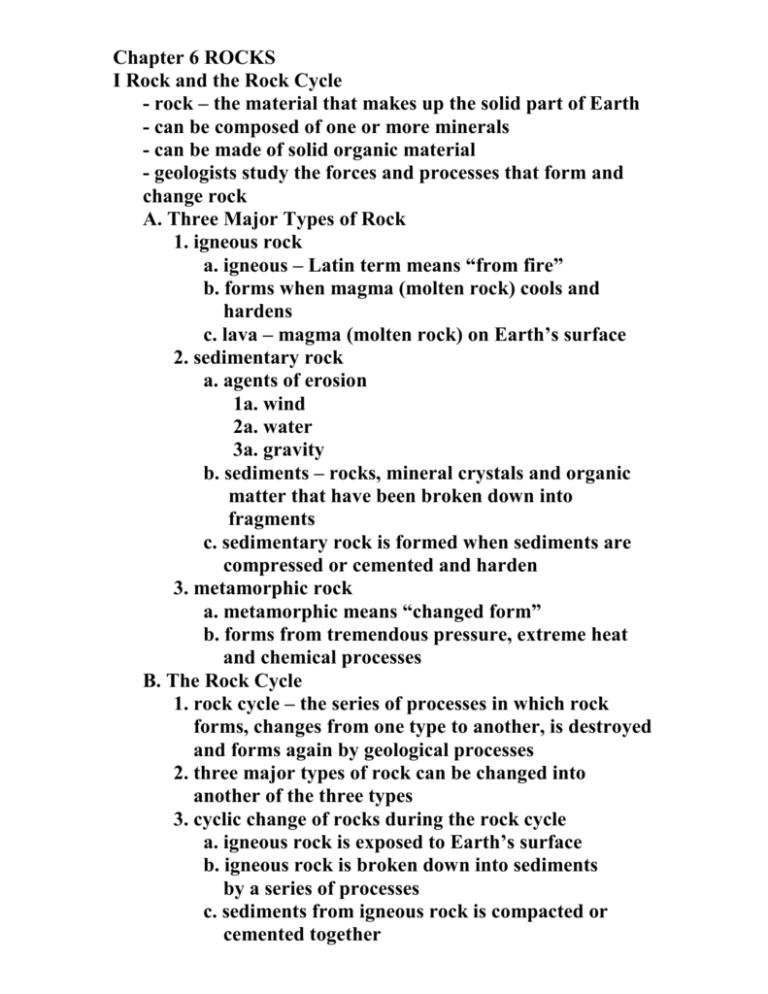Chapter 6 Section 1 Notes
advertisement

Chapter 6 ROCKS I Rock and the Rock Cycle - rock – the material that makes up the solid part of Earth - can be composed of one or more minerals - can be made of solid organic material - geologists study the forces and processes that form and change rock A. Three Major Types of Rock 1. igneous rock a. igneous – Latin term means “from fire” b. forms when magma (molten rock) cools and hardens c. lava – magma (molten rock) on Earth’s surface 2. sedimentary rock a. agents of erosion 1a. wind 2a. water 3a. gravity b. sediments – rocks, mineral crystals and organic matter that have been broken down into fragments c. sedimentary rock is formed when sediments are compressed or cemented and harden 3. metamorphic rock a. metamorphic means “changed form” b. forms from tremendous pressure, extreme heat and chemical processes B. The Rock Cycle 1. rock cycle – the series of processes in which rock forms, changes from one type to another, is destroyed and forms again by geological processes 2. three major types of rock can be changed into another of the three types 3. cyclic change of rocks during the rock cycle a. igneous rock is exposed to Earth’s surface b. igneous rock is broken down into sediments by a series of processes c. sediments from igneous rock is compacted or cemented together d. sediments become sedimentary rock e. sedimentary rock is exposed to intense heat and pressure f. sedimentary rock may be transformed into metamorphic rock g. under certain temperature and pressure conditions, metamorphic rock can melt h. the molten rock can cool and harden to form igneous rock 4. a particular body of rock does not always pass through each stage of the rock cycle (Fig. 2, page 126) C. Properties of Rock - all rock has physical and chemical properties - properties are determined by how and where the rocks formed - physical characteristics of rock reflect the chemical composition - the way that minerals and rocks form is related to the stability of the rock 1. Bowen’s Reaction Series a. minerals crystallize at different rates as magma cools b. as certain minerals crystallize, the magma’s composition changes - Why? - as minerals crystallize, they remove specific elements from the magma c. minerals generally form in the same order - Why? - melting/freezing points of a mineral is the same d. minerals form in two ways 1d. a gradual, continuous formation of minerals that have similar chemical compositions 2d. a sudden change in mineral types 3d. pattern of mineral formation depends on the magma 2. Chemical Stability of Minerals a. rate of mineral breakdown is dependent on chemical stability b. chemical stability – a measure of the tendency of a chemical compound to maintain its original chemical composition rather than break down to form a different chemical c. dependent on the strength of the chemical bonds d. minerals that are most resistant to weathering are the ones with the highest number of bonds between the elements silicon and oxygen 3. Physical Stability of Rocks a. rocks have natural zones of weakness 1a. sedimentary rock tends to break between layers 2a. metamorphic rock tend to break in layers where minerals align during metamorphism 3a. igneous rock aa. joints – evenly spaced zones of weakness in igneous rock that form as the rock cools and contracts bb. igneous rock will split at joints b. weakness may also form when rocks are under intense pressure 1b. when rocks are exposed to decreased pressure, joints and fractures open 2b. these areas of weakness are exposed and the processes of chemical and physical weathering begin






